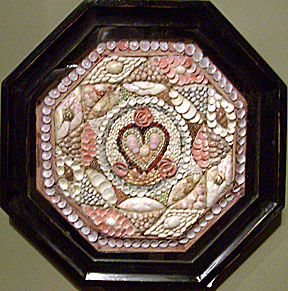
During the mid-19th century, sailors often spent years aboard ships
in search of whales or moving cargo from one port of call to another.
When they put into port to exchange cargo or gather provisions, they
often went in search of unique souvenirs to take back to their wives and
girlfriends. One of these, the sailors’ valentine, originated on the
island of Barbados in the Caribbean.
Most sailor’s valentines date from the early 19th century. Beginning in
1830, whaling ships set sail from Nantucket and later New Bedford,
Massachusetts in search of mighty whales, from which they extracted
whale oil used to grease the machines of the Industrial Revolution.
While Nantucket was the center of whaling in New England—at its height
nearly 400 ships called the island port home—these weren’t the only
types of ships that sailed the oceans of the world. Sailing ships, later
known as clippers because of their fast speed, sailed to all the major
ports of the world. From the early to the latter part of the 19th
century when steam-powered ships took over the seas, the sailors aboard
them were often gone from home for several years and missed their wives
and girlfriends.
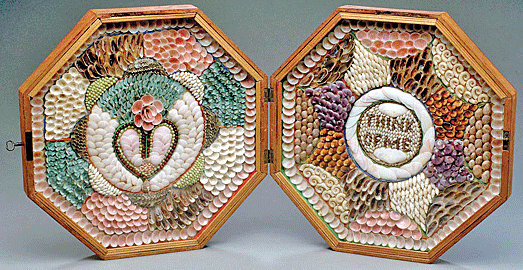
Between about 1830 and 1880, residents of Bridgetown, Barbados made
and sold unusual octagonal boxes filled with seashells, which later came to be
known as "Sailor’s Valentines" to the lonely English and American sailors.
From the 1630s to the end of the 19th century, Barbados was an important
port of call for sugar, rum, lumber, and fish. Because of this, a number
of shops catered to the souvenir trade. The Victorian love for
collecting and displaying exotic objects from afar possibly fueled the
industry and contributed to the popularity of these unique works of
shell folk art.
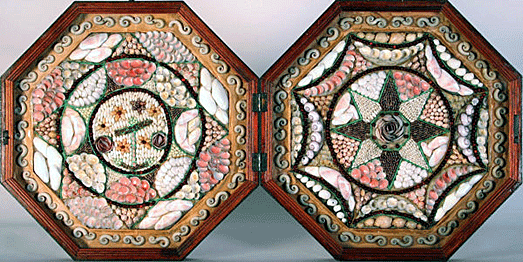
Historians believe that most of the sailors' valentines came from the
New Curiosity Shop on McGregor Street in Bridgetown, owned by two
English brothers, B.H. and George Belgrave, who hired locals to make the
valentines.
The local valentine makers constructed the special octagonal, hinged
boxes, ranging in size from 8 to 15 inches wide and 2˝-3 inches high,
using mahogany veneer for the sides and native cedar wood called
cedrella, for the bottoms. Then they lined the insides of the boxes with
colored paper, most often pink, onto which they placed cotton batting.
Next they glued hundreds of colorful tiny seashells in intricate
symmetrical mosaic designs incorporating hearts and flowers, which often
featured a compass rose or heart centerpiece. After gluing down all the
shells, the maker placed a piece of glass over the design to protect it.
The hinged versions became known as double valentines.
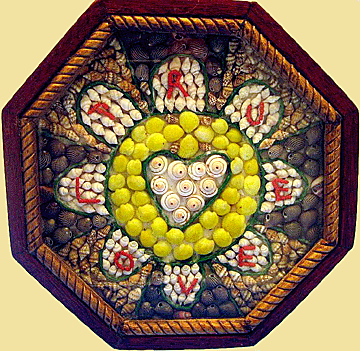 Sometimes
the makers incorporated a special sentimental message that a sailor
would request into the design, thus the name Sailors’ Valentines.
Sentiments typically appeared only on the smaller 9˝-inch double
valentines, which often displayed a heart motif on the opposite half.
Some of the more popular ones were “To My Sweetheart,” “To My Love,”
“Home Again,” and “From a Friend.” The larger 13˝- to 14-inch valentines
rarely had sayings, but instead had more intricate shell-work designs on
both sides.
Sometimes
the makers incorporated a special sentimental message that a sailor
would request into the design, thus the name Sailors’ Valentines.
Sentiments typically appeared only on the smaller 9˝-inch double
valentines, which often displayed a heart motif on the opposite half.
Some of the more popular ones were “To My Sweetheart,” “To My Love,”
“Home Again,” and “From a Friend.” The larger 13˝- to 14-inch valentines
rarely had sayings, but instead had more intricate shell-work designs on
both sides.
Today, Sailors’ Valentines command high prices at auctions and antique
shows. Some of the best, however, are part of the collections of the
New Bedford and
Nantucket Whaling Museums, the
Peabody Essex
Museum, all in Massachusetts, and
Mystic Seaport Museum
in Connecticut.
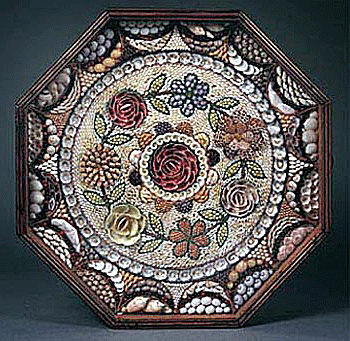 Collectors
value antique sailors' valentines for their beauty and unusual
qualities. But their high prices make it difficult for most beginning
collectors to acquire the originals. A small double valentine that
twenty years ago sold for $350 to $600, now sells for $500 to $1,500,
and the price for a large double valentine has jumped from $1,000 to
between $2,500 and $10,000—that is if either can be found.
Collectors
value antique sailors' valentines for their beauty and unusual
qualities. But their high prices make it difficult for most beginning
collectors to acquire the originals. A small double valentine that
twenty years ago sold for $350 to $600, now sells for $500 to $1,500,
and the price for a large double valentine has jumped from $1,000 to
between $2,500 and $10,000—that is if either can be found.
Plus, a thriving business making new sailors’ valentines has emerged on
Nantucket Many of these have frames that have been faux finished to
imitate the original woods and their designs copied to imitate the
originals. Beyond the souvenir shops, collectors must be vigilant
because many of these imitations have been sold as antiques.
Condition is important when considering the purchase of a sailors’
valentine. It should have most of its original shells and the box should
be as damage free as possible. The more popular ones with collectors are
those with motifs other than the heart and compass rose design, such as
anchors, vases of flowers, or detailed single flowers.
Read
more about whaling antiques.
